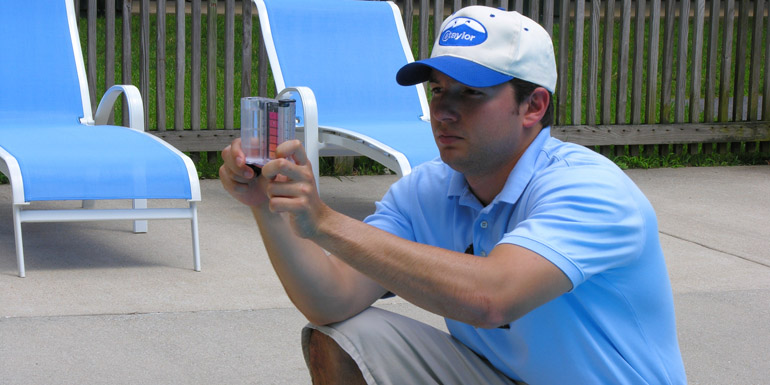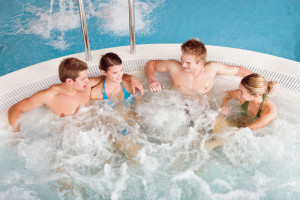
By Patricia Fitzgerald
There are plenty of misconceptions about water chemistry and testing floating around. Aside from the one about a dye that will detect people peeing in the pool, which can be helpful if swimmers believe it, they all impede our ability to manage water quality. So let’s do some myth busting.
Myth 1: Experienced pool/spa operators can tell if there are issues with water quality by simply looking at the water
Coloured water, owing to dissolved metal or an algae bloom, and cloudy water do indeed signal trouble, but our goal is to nip problems in the bud before the water gets to this extreme. So is it true, “If it’s clear, have no fear?” Absolutely not; without routine water testing, inadequately sanitized water cannot be detected in time to protect swimmers from harmful microbes and unbalanced water cannot be detected in time to protect vessel surfaces and equipment from damage.
Myth 2: From a water maintenance perspective, a spa is basically a little pool
Understanding the uniqueness of a spa (i.e. its higher temperatures, smaller volume, jetted water and likelihood of high bather loads) is important to establishing usage rules and a proper cleaning, testing and treatment regime. These insights will also explain why the disinfection and water-testing regulations for public spas are even more stringent than those for public pools.
Water temperature is a factor
Pool water temperature is generally 26 to 29 C (78 to 84 F), while spa water runs between 36 to 40 C (96 to 104 F). Heated water, coupled with jet action, promotes a buildup of contaminants in the spa. Consider that, without enforcement, most people do not shower first, so whatever is on their skin ends up in the water—from natural body oil, lotions and perfume to grime, sloughed-off skin cells and what is politely known as ‘cheek wash.’ Further, it is estimated an adult will carry about one billion bacteria into the water, some potentially detrimental to health.
Bacteria concerns
The most common spa-related ailments such as skin rashes and infections of the ear, urinary tract and cornea, are typically caused by the Pseudomonas aeruginosa bacteria. Legionella pneumophila is another bacteria found in spa water, which can be fatal to some individuals when inhaled with the aerosol from a spa. For most pathogenic bacteria, the optimal temperature for growth is between 37 to 40 C (99 to 104 F) (i.e. spa range). Certain bacteria populations can double in as little as 20 minutes if unchecked by a disinfectant. Harmful viruses, protozoans, yeasts and fungi shed into the spa and onto surrounding surfaces can also infect other users. Being immersed in hot water promotes sweating, and sweat contains some of the same metabolic wastes found in urine. In fact, I’ve read the average person will involuntarily release 50 mL (1.7 oz) of urine in addition to 200 mL (6.7 oz) of sweat during a 20-minute soak. The relatively small water volume of a spa means the chance of coming into contact with these contaminants, before they can be chemically destroyed or filtered out, is commensurately greater than in a pool.
Quicker chemical reactions
Hot water also speeds up chemical reactions. For every 10- C (18- F) increase in temperature, chemical reactions increase twofold. Between the heavy load of organic waste and the more dynamic chemistry, it is possible for two people in a 1,500-L (400-gal) spa to deplete a sanitizer level of two parts per million (ppm) bromine or one ppm free chlorine in just 15 minutes. (When you consider the people-to-water-volume ratio, those two folks in the spa is the rough equivalent to 1,250 people in a 1-million-litre (250,000-gal) public pool or 100 people in a 75,000-L (20,000-gal) residential pool!)

Beyond these health issues, spa operators must also be concerned about rapid changes in water chemistry, which affect both the efficacy of chlorine and water balance. For instance, aeration drives pH up. Potassium monopersulfate (MPS), the key ingredient in popular non-chlorine oxidizing shocks, will lower both pH and total alkalinity (TA).
Spa surfaces, plumbing and most especially the heater are at increased risk for scaling if the water becomes unbalanced. Calcium’s (Ca) solubility is inversely proportional to temperature—as water temperature increases, less calcium is able to stay dissolved, resulting in crusty deposits that will eventually lead to increased operating costs and expensive repairs.
Hot jetted water evaporates faster than cool, calm pool water, too, meaning total dissolved solids (TDS) will also build up faster in a spa and contribute to corrosion and cloudy water. Sanitizing with dichlor (C3HCl2N3O3), while convenient, pushes cyanuric acid (CNOH)3 (stabilizer) levels beyond the recommended range of 25 to 50 ppm in very short order, making it hard for chlorine to do its job. It almost goes without saying, treatment chemicals must be administered very precisely in such small bodies of water—we call it ‘teaspoon chemistry.’






